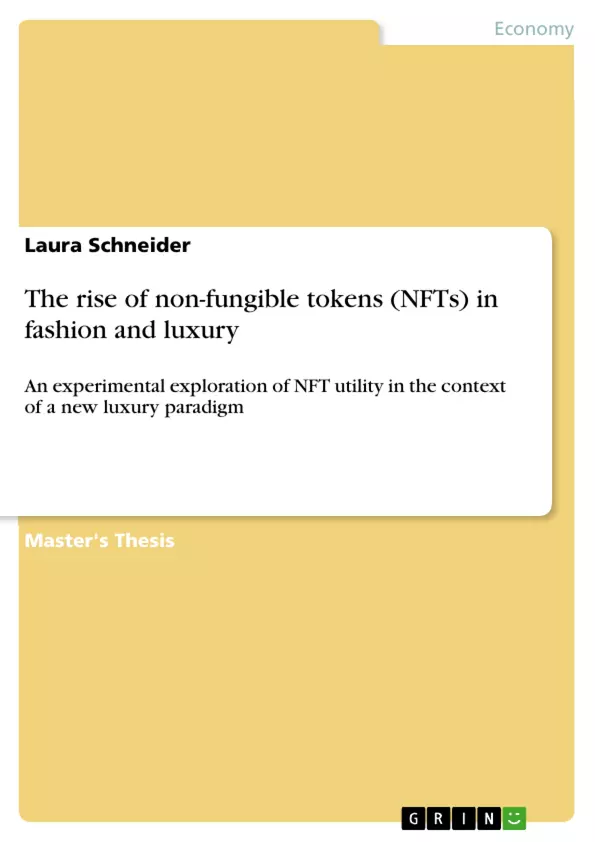The concept of the metaverse and non-fungible tokens has become ubiquitous, and fashion and luxury companies are faced with the need to define a thorough strategy to tackle its business impact. Despite some brands acting at the forefront of NFT adoption, the utility of the infant technology remains unclear. By conducting a 2x2 factorial design experiment, this research creates insights into guidelines for NFT strategies for fashion and luxury companies. First, the high importance of connecting NFT offers with experiences is confirmed. Second, a coherence of values between NFT technology and the luxury industry was illustrated. Finally, the experiment suggested a high difference in perceived utility of real-world asset NFTs and digital asset NFTs for mainstream brands, while the difference could not be proven in the case of luxury companies. In conclusion, the NFT strategy matrix was developed, which introduces four dimensions of brand loyals, brand collectors, fad enthusiasts and fad curious differentiated by their brand loyalty and desired NFT utility. This framework aims to provide a tool for fashion and luxury companies to cater their holistic NFT offering to different customer groups. In general, it is advisable to move from digital asset NFTs toward real-world asset NFTs in order to engage consumers with rare experiences in a virtual or physical setting and deploy the technology as an experiential marketing tool.
Table of Contents
- Introduction
- Literature review and theoretical framework
- Introduction to blockchain
- Technological functionality
- Second generation of blockchain and NFTs
- NFT project classes
- Outlook for Blockchain and NFT technology
- The industry of fashion and luxury
- Definition and industry overview
- The new notion of luxury
- The relevance of Experiential marketing
- Fashion and luxury's approach to Experiential marketing
- NFTs in fashion and luxury
- Coherence of values
- Industry NFT projects
- Critical assessment
- Sub-conclusion and research question
- Introduction to blockchain
- Methodology
- Research philosophy and theory development
- Research approach and design
- Data collection
- Data preparation
- Research ethics and delimitations
- Data validity and reliability
- Data analysis
- Data overview
- Hypothesis testing
- Descriptive statistics
- Analysis of variance
- Correlations
- Discussion
- The importance of experiences
- Experience realms in RWA NFTS and DA NFTs
- Business approach to experience management
- The relationship of NFT type and Brand type with NFT utility
- Diffusion of NFT type and Hype cycle
- High NFT utility in luxury
- Luxury DA NFTs with highest utility
- Business assessment
- Recommendations for fashion and luxury companies
- The NFT strategy matrix
- Implementation and advantages of NFT strategy matrix
- The importance of experiences
- Conclusion
Objectives and Key Themes
This research aims to investigate the utility of NFTs for fashion and luxury companies in engaging customers and creating a sustainable competitive advantage. The work explores how NFT technology can be leveraged within the context of a new luxury paradigm and provides insights into guidelines for NFT strategies. The study utilizes a 2x2 factorial design experiment to investigate the perceived utility of NFTs and analyze the impact of brand loyalty and desired NFT utility on consumer perception. Here are some of the key themes explored in the research:- The impact of NFT technology on the fashion and luxury industry.
- The importance of experiences in driving NFT utility.
- The coherence of values between NFT technology and the luxury industry.
- The difference in perceived utility of real-world asset NFTs and digital asset NFTs.
- The development of an NFT strategy matrix to guide brand-specific approaches.
Chapter Summaries
- **Introduction:** The chapter introduces the research topic, discussing the growing relevance of the metaverse and NFTs within the fashion and luxury sector. It highlights the contrasting approaches taken by different brands, ranging from early adopters like Gucci to those struggling with NFT adoption. The chapter concludes by outlining the research question, focusing on the utility of NFTs for engaging customers and fostering a sustainable competitive advantage.
- **Literature review and theoretical framework:** This chapter provides a comprehensive overview of blockchain technology, its evolution, and the emergence of NFTs. It explores various NFT project classes and examines their potential impact on different industries. The chapter delves into the fashion and luxury industry, defining its characteristics and analyzing the shifting concept of luxury in the contemporary context. It also highlights the importance of experiential marketing within this industry and analyzes how NFTs can be integrated into this strategy.
- **Methodology:** The chapter details the research methodology employed in the study, focusing on the research philosophy and theory development. It describes the research approach and design, including data collection methods, data preparation processes, and ethical considerations. The chapter also discusses measures taken to ensure data validity and reliability.
- **Data analysis:** This chapter presents the findings of the study, providing an overview of the collected data and outlining the hypothesis testing process. It analyzes the descriptive statistics, explores the results of variance analysis, and examines correlations between different variables.
- **Discussion:** The chapter interprets the findings of the study, examining the key themes and drawing conclusions regarding the utility of NFTs in fashion and luxury. It emphasizes the significance of experiences, analyzing the impact of different types of NFTs on consumer perception. The chapter further explores the relationship between NFT type, brand type, and overall NFT utility, providing insights into the optimal strategies for different brands.
Keywords
The main keywords and focus topics of this research include non-fungible tokens (NFTs), metaverse, fashion and luxury industry, experiential marketing, brand loyalty, NFT utility, digital asset NFTs, real-world asset NFTs, and NFT strategy matrix. These terms highlight the central themes of the work, encompassing the disruptive potential of NFT technology, its application within the luxury sector, and the importance of tailoring brand strategies for maximizing consumer engagement and driving sustainable competitive advantage.- Quote paper
- Laura Schneider (Author), 2022, The rise of non-fungible tokens (NFTs) in fashion and luxury, Munich, GRIN Verlag, https://www.grin.com/document/1298717



